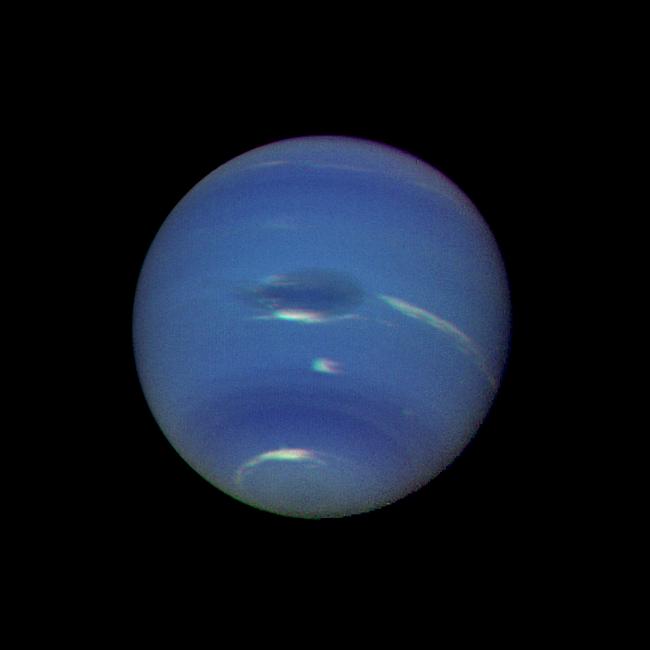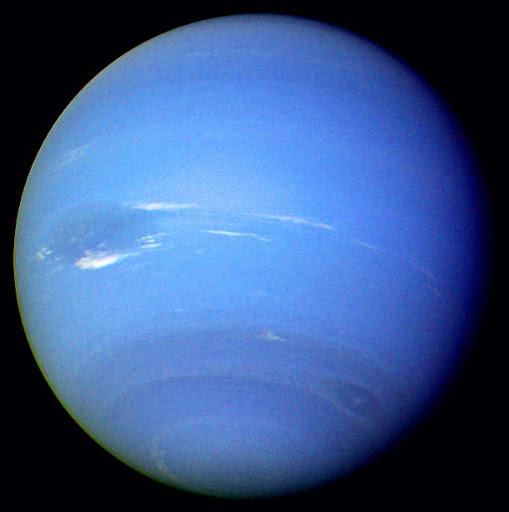
Neptune is very far away from Earth. It orbits the Sun approximately 30 times the distance from the Earth to the Sun (30 AU). It is only observable with the aid of telescopes or strong binoculars, and was not therefore visible to civilisations in antiquity. The planet has an incredibly active atmosphere and our knowledge of it is still very limited. So are there any missions planned to visit this distant planet? And how long would it take to get to Neptune? Let’s take a look.
Neptune – Quick Facts
- Average Distance From The Sun: 4,501,000,000 km (2,796,791,736 mi)
- Radius: 24,764 km (15,387 mi)
- Average Surface Temperature: -214°C (approx -353°F)
- Day length: 16 Earth hours
- Year length: 165 Earth years
- Number of moons: 14
- Closest Distance to Earth: – 4.3 billon kilometers (2.7 billion miles)
- Furthest distance to Earth: – 4.7 billion km (2.9 billion miles)

How far is Earth from Neptune?
At the time of writing, Neptune is currently 4,343,898,102 Km from our planet Earth. At this distance, light takes 4 hours, 1 minutes and 29.68 seconds to travel between the two planets.
The closest that Earth and Neptune approach each other is when both planets are in opposition. Opposition happens when Earth moves between an outer planet and the sun. This happens around once every Earth year,1 or 2 days later each year from our perspective on Earth. The closest approach that these planets can make, is when they are aligned, Neptune is at its closest position to the Sun (perihelion) and Earth is at its farthest (aphelion).
At it’s farthest, Neptune can be as distant as around 4.7 billion km (2.9 billion miles) from Earth. This happens when the planets are on different sides of the Sun to each other. At it’s closest, it can be as far as around 4.3 billon kilometers (2.7 billion miles) from Earth. As the orbit of Neptune and Earth are elliptical, they do change slightly over time. So these closest and farthest distances expand and contract over time.
According to theskylive.com, the closest that Neptune and Earth will reach up to the year 2100, will be on Tue Oct 29 2041 at a distance of 28.81417973 AU, or 4,310,539,942 km.
How Long Would it Take to Get to Neptune?
The time it takes light to travel between Neptune and Earth at average distance, is a little over 4 hours (240 minutes). But of course we can’t travel at the speed of light. So far, there has only been one mission to visit Neptune, Voyager 2, which conducted a flyby on it’s tour of the solar system.
Voyager 2 launched on August 20, 1977, started observing Neptune on June 5, 1989 but reached it’s closest approach with the planet on August 25, 1989. At the close approach, Voyager 2 was a mere 4,950 km above Neptune’s north pole. So mission flight time was roughly 12 years and 5 days for arrival at this distant giant.
Placing a craft in stable orbit, or dropping a probe into the atmosphere could take considerably longer. Launches need to be timed to align with optimal distance, as well as the position of other planets to allow for a gravity assist. The approach would also need to be calculated to allow the craft to slow and enter orbit at an acceptable speed.
What is the Shortest Trip?
Voyager 2 is the only craft to have visited Neptune so far, with a flight time of 12 years and 5 days to close approach. Until another mission is launched, this is the quickest trip to this icy neighbour so far.
How Often Does The Closest Approach Occur?
The Earth and Neptune come into Opposition roughly every 365 – 368 days. They are in their closest approach when they are in opposition. However, given that their orbits are elliptical, the distance of close approach will change over time on a longer cycle. As mentioned above the closest the planets will reach this century will occur in the year 2041.

Missions To Neptune
So far, there has only been one mission to Neptune, as mentioned above:
- Voyager 2 – Launched Aug 20, 1977 – Closest Approach Aug 25, 1989 – Flight Duration – 12 years, 5 days. This mission was a flyby in which Voyager 2 collected data about the planet, it’s atmosphere and its moons. Voyager 2 continued to collect data up until October 2, 1989.
Voyager 2 collected data and photos of some of Neptune’s moons too. There were plans to move the craft closer between the planet and the moon Triton, but these had to be altered to allow for a clearer path away from ring debris. While we had been actively investigating the planet for decades indirectly through telescopes and observations, this mission was answered many questions that needed direct study.
We learned a ton about the lively atmosphere, the magnetosphere and it’s accurate mass. We learned about the planet’s storms and periodic spots similar to Jupiter’s red spot.
Future Missions To Neptune
At present there are no active plans to return to Neptune. However, there are still some proposals/concepts for potential missions being explored by many stakeholders. The ESA, NASA and the CNSA are all exploring potential missions for a return to the 8th planet but time will tell if any of these plans eventually get off the ground.
How Far Is Neptune From The Other Planets?
The following are average distances between Neptune and the other planets in the Solar System:
- Distance From Neptune to Mercury: 4,443,090,000 km or 2,760,936,126 miles
- Distance From Neptune to Venus: 4,392,800,000 km or 2,729,685,920 miles
- Distance From Neptune to Mars: 4,273,060,000 km or 2,655,279,484 miles
- Distance From Neptune to Jupiter: 3,722,670,000 km or 2,313,267,138 miles
- Distance From Neptune to Saturn: 3,076,400,000 km or 1,911,674,960 miles
- Distance From Neptune to Uranus: 1,627,450,000 km or 1,011,297,430 miles